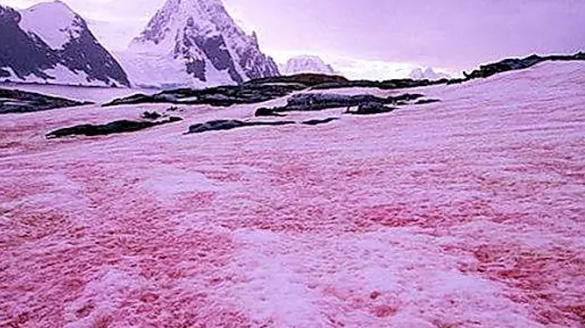The American mountains of Utah have transformed into shades of pink, red, and orange thanks to a natural phenomenon called "watermelon snow." While summer officially begins today, snow remains unusually accumulated at Tony Grove Lake in Cache County, exhibiting a pink hue, as reported by Scott Hotaling, an assistant professor in the Department of Watershed Sciences at Utah State University, in an article for the British newspaper "Daily Mail." He explains that this phenomenon is due to the proliferation of green algae on the surface. Hotaling specializes in watermelon snow and algae, stating, "Snow algae produce a pigment that essentially darkens their cells, serving as a protection mechanism against ultraviolet rays, hence protecting DNA and other aspects from damage. However, it also has a secondary benefit, which is allowing their cells to absorb heat that melts the surrounding snow, enabling them to access water, because, you know, we are here in a world of water right now, but nothing like that is accessible."
**What is Watermelon Snow?**
What is known as "watermelon snow" is produced by microscopic algae characterized by single-celled photosynthesis with a red hue. It can be found in snowfields around the world. As temperatures rise, the algae release spores that grow and produce a unique color. The red pigment mixes with the green pigment present in all algae, creating the pink appearance.
**An Artistic Canvas**
Initially, scientist Hotaling contemplated the beautiful artistic aspect of nature: "Is anyone painting it or something like that?" As the color attracted tourists, visitors who touched the pink snow noticed that the bottoms of their shoes had turned a brilliant orange, leaving behind peach-colored footprints.
**A Phenomenon**
In 2020, scientists in Antarctica captured stunning images of vibrant watermelon snow. The remarkable photographs taken near a former British research station in Antarctica revealed this phenomenon. Photos were also captured at the former Faraday British station, which was sold to Ukraine for £1 in 1996. It is now known as the Vernadsky Station, and the Ukrainian Ministry of Science and Education revealed the blood-colored snow.
Ukrainian scientists stated that such snow contributes to climate change, as the red raspberry color reflects less sunlight and melts faster. As a result, more and more bright algae form in the snow.




